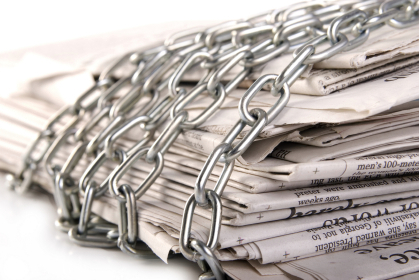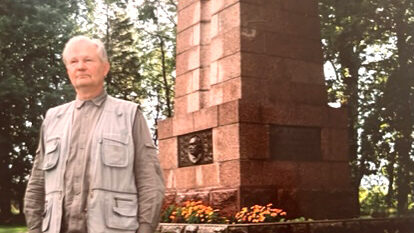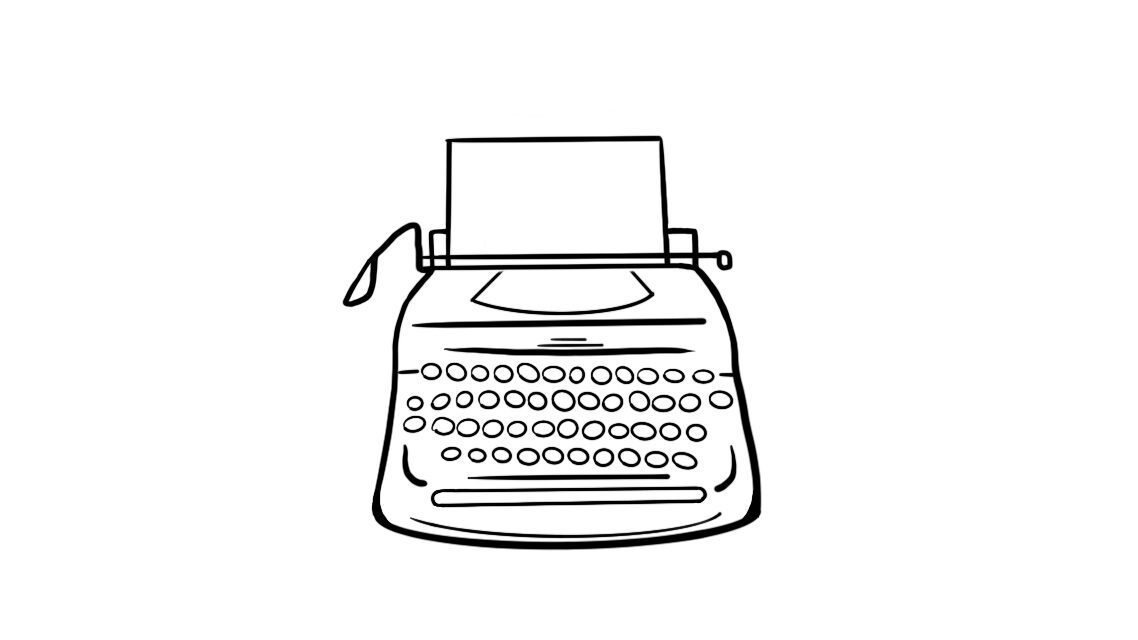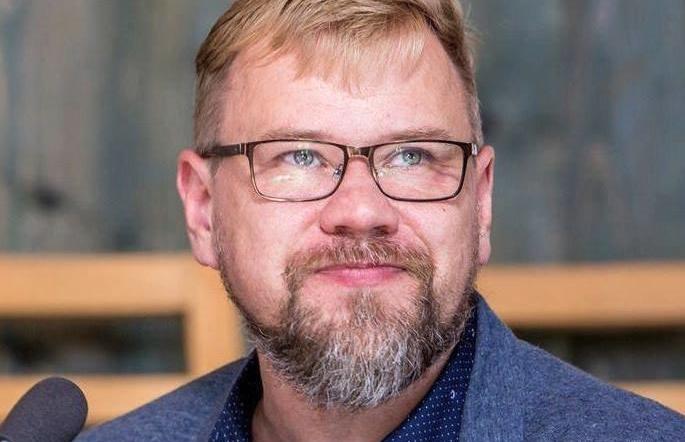Reporters Without Borders defends and advocates for the freedom to be informed and to inform others throughout the world. Headquartered in Paris, it runs ten offices abroad with more than 150 correspondents.
Needless to say the situation in Soviet occupied Estonia contrasted starkly with the current press climate. The press, during the total Soviet period was firmly relegated to fulfilling the role of communist party propagandist. Any deviation called for censorship. The only targets for criticism were to be things that “blocked the advancement of communism or weakened its position in society.”
During the post-war period, the press in Soviet-occupied Estonia took its marching orders directly from Moscow. Its content and political stance were set by the Communist Party of the Soviet Union and passed on through a rigid hierarchy. It propagated party goals and fulfilled those tasks which were assigned as per the annual plan. State authority did not view newspapers/periodicals as media for information but rather as social influence mechanisms.
(As an example of the strict political correctness to which the press was forced to adhere were the terms 'emigrants', ‘traveled abroad' etc. Instead of referring to those Estonians as ‘political refugees', who in 1944 were forced to escape the Soviet invasion, Soviet censorship required all publications to promote an historic falsehood. Those that left in advance of the invading Red Army in the fall of 1944 and who managed to escape the Iron Curtain thereafter, did so of their own free choice – they 'emigrated'. Any implication that it was otherwise would be strictly censured. The notion of ‘political refugees' did not exist. This of course changed dramatically in practically all of the Estonian media in the late 1980's.)
Throughout the Soviet Union, the regionally managed press mirrored each other in types of publications: the party newspaper, the comsomol (communist party youth section) newspaper, the newspaper of the creative unions (writers, artists, etc.), newspaper for the farming community (basically collective farms), sports periodicals and municipal/local newspapers. New media start-ups were rare. For anything other than local publications, a new newspaper/periodical required the permission of the Soviet Union's Communist Party Central Committee Secretariat. The number and the targeted readership of publications through the Soviet period therefore did not vary.
All newspapers/periodicals were the public voice of some institution. Publications with general content were under the control of the party or the comsomol. Publications with Estonia-wide circulations were distributed six days a week. Local newspapers three times a week. After WWII publications enjoyed large circulations with the “Rahva Hääl” print run at 82,000. This was achieved through a mandatory subscription policy for some individuals. After Stalin's death the circulations decreased.
During Stalin's era radio broadcasting changed from a listener-at-home to a listener-at-workplace-or-public-space arrangement. Loudspeakers were placed in factories, offices, open spaces to ensure that no one could avoid the political propaganda message. Radio broadcasting became a major tool for legitimizing Stalin's repressions. Again after his death, the ideological importance of radio slowly diminished.
By the 1960's Eesti Raadio was integrated within the political system. Financial resources were guaranteed within the state budget of a planned economy where the needs of propaganda outlets had high priority. In Estonia, in addition to the rigidly controlled regular state radio, Vikerraadio was able to able to broadcast a slightly a more relaxed program, with slightly less emphasis on ideological correctness.
In 1955 the Tallinn television studio was established. The national news program “Aktuaalne kaamera” was on air by 1957, at which time daily news was made available to the public. Observers have noted that by the end of the 1960's Estonian TV had attracted many radio journalists, who brought with them a more independent stance and the political milieu within the TV community was less subservient to Communist party dictates.
Laas Leiavt – Estonian Life No. 34 2012
According to Lenin, the most important role of the media in Soviet society was to “serve as an instrument of socialist construction”. ‘Censorship' in the Soviet empire involved two aspects: a) control over content and forms of public information; b) and the appartus applying the control. As a mechanism for control, censorship was also repressive. It destroyed films, art, plays.
Perhaps in recognition of this the Soviets hid the existence of institutionalized censorship. The words censor and censorship were also placed on the list of forbidden information. Naturally freedom of the press and freedom of speech were publicly declared. But officially , censorship did not exist in the Soviet Union or its republics. But there was a caveat. The constitution of the Estonian SSR guaranteed the freedoms of speech and the press, but only on condition that the freedoms be used for ”the consolidation and development of the socialist order”.
If these freedoms were ‘misused', interpreted as harmful for the system of agitation and propaganda, substantial penalties would ensue: imprisonment for six months to seven years, possibly accompanied by two to five years of deportation, or just deportation.
The word ‘censorship' appeared for the first time in a newspaper in Soviet-occupied Estonia in 1987, when substantial liberalization was already well-rooted, especially in Estonia. (But consider this. In August of 1987 the Estonian authorities allowed a demonstration in Hirve Park, Tallinn where the communist order and regime were loudly condemned and where nothing less than full independence was demanded for Estonia. The KGB of course video-taped the affair but arrested no one. In 1987 Estonia was also the first to officially sanction as lawful the creation of the Estonian National Independence Party (ERSP), an anti-communist party promoting Estonian nationalism who openly declared that the communist power should be usurped and replaced by a democratic regime. For observers, these two developments seemed to have been much more radical in nature than the public acknowledgement of state-run censorship. Yet the existence of censorship was only officially revealed in the same year.) In the late 1980s censorship restrictions were significantly eased and in October 1990 censorship in Estonia was abandoned by the government.
In the immediate post-war era, the most dangerous enemies of the new Communist regime and its ideology was the peoples' historical memory of the Estonian nation and of nationalism. The thrust of Soviet censorship was therefore Russification and the destruction of Estonian national culture. Libraries had to be ‘cleaned up' and millions of copies of printed matter destroyed. Already during the first Soviet occupation of 1940 this was initiated and continued after WWII until the early 1960s. ‘Harmful literature', i.e. all books and periodicals published in the pre-war Republic of Estonia were confiscated from bookstores and libraries, private and public. Thus some 86% of books and all periodicals published during independent Estonia were named in the lists of banned publications.
By 1947 special three-person commissions were formed (reps of the censorship administration, the Estonian Communist Party and the party youth, the Comsomol) for purging school libraries. Bi-weekly the submitted progress reports indicated that they destroyed 25,000 books annually for five successive years.
In the 1950s some Soviet books were also listed as forbidden. The reasoning matched Orwell's Ministry of Truth. Changes in Communist Party ideology were inevitable. On occasion past events, personalities, topics, etc. had to be ideologically reconsidered and declared dangerous and anti-Soviet. Historical stalwarts became pariahs overnight. A classical case was the fate of Nikolai Karotamm. As first secretary of the Estonian Communist Party, he took his marching orders from the party leadership in Moscow. At the 1950 plenum of the Estonian Communist Party, amongst other misdeeds, he was severely criticised for being too lenient with nationalistic elements in the society and not aggressive enough in forced collectivization of agriculture. He was replaced. In 1953 in a report on the control of 47 libraries it was indicated that a 1947 Karotamm speech on the occasion of the 30th Anniversary of the Great October revolution had been found. Orders directed the immediate removal of this document from all public locations. Karotamm's time-honoured place in Soviet history had been re-evaluated and his status drastically lowered.
What was the extent of the destruction of books under Soviet rule in Estonia? Estimates have ranged from 10 to 20 million. However ‘Special Collections' were established at a few specified libraries such as the Academy of Sciences to which only a designated list of functionaries (including the NKVD/KGB) had access. These collections were also depositories of foreign periodicals not allowed to the public, including Estonian language newspapers published in the refugee community.
Who managed the Estonian implementation of censorship, a taboo subject not to be discussed openly? The Secretary General of the Estonian Communist Party; the Politburo of the Central Committee of the Party; the Agitation and Propaganda Department of the Central Committee; the KGB's Fifth Department (before the late 1960's, the Second Department). The KGB in fact decided which names, roads, factories, educational facilities etc. were not to be publicly mentioned. They also reviewed the manuscripts of scientists in research institutions.
Laas Leiavt – Estonian Life No. 35 2012
GLAVLIT was the executive institution heading the executive and administrative responsibilities for censorship of the press and other media in the Soviet Union. The Estonian Gavlit was directly subordinate to Moscow. Censors were located in all bigger cities and in Estonia in all district towns, with officers in broadcasting, publishing and postal services.
In general, dominant roles in issuing directives for censorship were the Communist Party and the KGB. In spite of the highly structured censorship system the general priciple to follow was: what was not explicitly allowed was certainly forbidden. Some notable examples: The Estonian Academy of Sciences, with their collection of foreign books to which access firmly restricted held foreign books in Chinese, Japanese and other languages which could not be properly controlled because the controllers did not know the languages. Glavlit ordered all of these publications destroyed in 1953. In 1966 Glavlit found that a visitor had written a ‘politically incorrect' observation in the visitors' book of the State Art Museum in Estonia. The page had to be ripped out of the visitors' book.
Only a limited number of officials knew what was specifically allowed, what was forbidden and banned info was detailed on lists. This helped to maintain an efficient means of intimidation to make people obedient to authority. The latest issue of the List of Data Banned in Publications, Radio and Television containing 183 pages was issued in 1987. It contained data considered to be state and military secrets. It also listed certain topics such as big disasters with human losses, everything related to the armed forces, criminality, jails and obviously censorship itself. Information was classified to conceal misdeeds and inefficiency, the lack of goods and services. In Estonia lists also included the presence of Soviet military in the country, anything that could remind people of independence in the 1920s and 30s and the Soviet annexation in 1940.
The list was regularly updated to mirror changes in official policy and ideology. Thus the same names, facts, information could be forbidden at one time and allowed at another. Naturally, upon the issuance of a new list the previous one had to be destroyed.
In the years after the war Õhtuleht published a story about the Leningrad Opera's performance at the Tartu Officers' Club indicating the presence of he Soviet military in Estonia, a military secret. The newsletter of machine and tractor hiring stations published entire lists of names of tractor drivers who have participated at a ‘socialist labour competition'. Since here were two drivers for every tractor, it was possible to deduce the number of tractors in Estonia, a state secret.
All reference to the lack of goods and services in the USSR had to be removed from public texts. Noorus (Youth), the voice of the Communist youth organization, published a story of a visit to a church: “The church was crammed with people. // They were dressed in Italian, Belgian, Dutch and nylon coats and jackets. The censor wasn't pleased. They story indicated that there was widespread interest in the church, which the Party was actively discouraging by closing churches and teaching mandatory university subjects such as” scientific atheism.” The article also implied that Soviet-produced apparel was inferior and there wasn't enough of it.
A political glossary was developed listing preferred (and mandatory) usage of certain descriptive terms. This helped to create many dogmas and myths that reinforced correct public discourse. The October Revolution was known as the beginning of a new era in mankind's history; the working class as the most progressive class in society; the Soviet military takeover of Estonia as the Socialist Revolution of Estonia's working class. Words such as proletariat, revolution, communism, socialism, party were only to be used in a positive sense. Other words such as nationalistic, nation, bourgeois, capitalist always negatively. The 1978 secret Council of Ministers decree, known as the official guideline for Russification all words with a national connotation were banned. Thus the word Estonia had to be followed Soviet Socialist; the words blue, black and white could not be used together. The word homeland took on a different meaning as in the introduction to a history text-book on Estonia which begins with: “Our homeland is the Soviet Union and her capital is Moscow.” In the late 1980s previously forbidden words regained the original meaning.
After the 1950s, the fewer standards were imposed on the form of texts. Editors and writers were able to sometimes dodge the censorship requirements through elaborate linguistic devices when handling sensitive or forbidden topics. Cultural publications especially employed parody and other literary schemes which could not be targeted as impermissible with total certainty. Journalists became skillful in injecting messages “between the lines.”
With this the practical function of censorship was given to editors, both in the print as well as the broadcast media. Provided with a list of prohibited information and instructed to hold their broadcasting programs or publications in the correct ideological stance. Then the censors of Glavlit controlled the work of the editors, giving permission or denying it as necessary.
Laas Leivat – Estonian Life No. 36 2012
In 1979 the Chief Directorate for the Defence of State Secrets of the Estonian Council of Ministers sent to the editors of major newspapers a classified secret letter which contained amongst other observations the following: The largest number of censorship violations have occurred with the publishing of the population of towns with less than 50,000 residents. It is forbidden to reveal how long the military training of junior officers, sergeants and specialists lasts, also how many troops are stationed in regions close to the border. The pilfering of pharmaceutical narcotics is not to be mentioned. The capacity of oil refineries is to be kept secret. The list of forbidden items was long and thorough.
Press censorship restrictions did not allow the criticism of key Soviet institutions themselves or the USSR itself. But allowed and even encouraged were establishments of a lower rank, or examples of bad work or individual people. Such criticism was deemed to be exposure of a “deviation” from the Soviet system, that had to be corrected to help strengthen and improve the system as a whole.
During the Soviet era “Pikker” (Lighting) was an Estonian satirical periodical. In 1973 two articles criticized the Soviet planned economy. They were ordered removed by pre-publication censorship. But articles referring to single shortages or the unsatisfactory discipline of workers, which did not allow for the expected fulfillment of the state economic plan were deemed publishable.
Tartu's Newspaper “Edasi” (now Postimees) was to publish a photo of the Victory Day dignitaries greeting the parade from the reviewing stand in the1970s. A lone Soviet Soldier could also be seen on the picture. But the military were not supposed to be in Tartu. The censor's instructions: Replace the soldier's hat with a pigeon that had just flown by the men on the stand.
Sometimes criticism of individuals and cases of very specific shortfalls or mistakes would extend to criticism of the system as a whole. Writers and editors got the knack very early on of writing the message between the lines and readers got used to deciphering it, even though hidden opposition was still rare during Stalinism. Eventually in the Estonian press it spread gradually, but widely, especially in the periodicals covering cultural subjects.
In 1946 (fourth Soviet Five Year Plan) “Valgamaalane” (Native of Valga) published a story depicting the future vision for the city of Valga five years in the future. Deficits in goods and food coupons would be unnecessary. Shops would have plenty of variety and quantity of goods to sell. Women street peddlers trying to selling used items would disappear. The quality of bread will have improved with people in 1946 joking about finding bits of straw and rats in their bread. Valga's brewery would be sufficiently supplied with bottles and liquid refreshment available at anytime. Local industry will flourish with raw materials well-supplied. And of course the fourth Five Year Plan will “take us closer to our happy future, to Communism”. Pre-publication censors passed the article. It however caused a furor in Moscow and the chief of the Estonian Glavlit was fired. Some months later the same publication carried an article describing the plight of workers in Greece who were in dire need, eating poor quality bread containing soya and maize etc.
During the People's Court election of 1949 Stalin's name was misspelled in a pamphlet. All of the print run was gathered up and destroyed. The censorship authority made a serious error in 1973 by letting Lenin's portrait to be placed on the back cover of a youth magazine.
A special watchful eye was kept on publications of Estonian war-time refugees deemed correctly to be the most anti-Soviet. Glavlit reported to the Estonian Communist Party Central Committee that in 1970, 4,196 copies of various types of exile publications were sent to Estonia. Of these 743 were confiscated. In 1971 these quantities rose to 6, 163 with 1,261 being confiscated. Incoming foreign mail was closely monitored by the KGB. The confiscated materials were supposedly promoting the “bourgeois-nationalist order”. In any case a positive mention of the pre-war Estonian independent republic was forbidden.
The years of the German occupation was also taboo. In 1947, 10,200 copies of the 1948 calendar year were destroyed for the calendar format was similar to those issued during the occupation in 1944, with the weeks beginning with Sunday rather than Monday as was the Soviet style. An investigation was also launched to find those responsible for omitting Soviet holidays.
It would be naïve to suggest that Glavlit, the KGB, the Central Committee and all other officials involved in the control process were efficient. Disputes between the different authorities, admonitions, decisions within the party's governing structures had its effect in Estonia. The country, as a peripheral area of the USSR became even more obliged to follow the dictates of the central authority, Moscow. Some researchers have suggested that censorship was not only a means of instilling Soviet instincts and responses but also, especially for Estonia, a process of Russification.
(Sources for the preceeding four articles: “Rääkimine hõbe, vaikimine kuld”, Mart Soidro; “Practice of Soviet censorship in the press: the case of Estonia”, Epp Lauk, an academic paper; “Nõukogude tsensuuri jalajälgi avastamas”. Olev Liivik; “Tsentsuur Eesti NSV-s ja tema peremehed”. Kaljo-Olev Veskimägi.)
Laas Leivat – Estonian Life No. 37 2012




